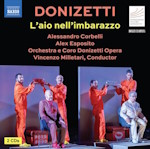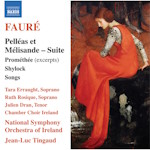
Christoph Demantius (1567-1643)
Johannes-Passion
Ensemble Polyharmonique/Alexander Schneider
rec. 2022, St. Georg-und-Mauritius-Kirche, Flemhude, Germany
Texts and translations included
cpo 555 583-2 [62]
Christoph Demantius is not a really household name among music lovers – at least, not outside Germany, where he is best-known for the two under review. That is no surprise, given that Passiontide was and is one of the main parts of the ecclesiastical calendar in Lutheran Germany. However, Demantius was a prolific composer who left a lot of little-known sacred and secular music The present disc bears witness to the quality of his oeuvre and should urge ensembles to explore his output.
Demantius was born in Reichenberg (now Liberec) in Bohemia, where he may have attended the Lateinschule. In 1593 he matriculated at Wittenberg University, but moved to Leipzig in 1594 or 1595. There, he published his first collection of music. After working some years at Zittau as Kantor, he was appointed in the same position in Freiberg in 1604 where he stayed until the end of his life. He seems to have made a name for himself quickly, but he also experienced the effects of the Thirty Years’ War. The last extant collection dates from 1620; two collections from 1642 are lost. His oeuvre includes a large number of occasional works, especially wedding motets and funeral music, which attest to his important role in Freiberg musical life.
The two works at the core of the present disc were published together in 1631. The St John Passion is the last specimen of the so-called ‘motet Passion’, which is polyphonic and does not allocate the words of characters in the story to a solo voice. However, that does not mean that Demantius’ setting is conservative. It is written in the stile antico, but is notable for its text illustration, which is a feature of Demantius’ music in general. In New Grove he is called “one of Lassus’s worthiest successors.” Obviously there are plenty opportunities to depict words or phrases in the story of Jesus’s passion, as reported by John. An early example is his arrest, for instance “they went backward, and fell to the ground”. Later, the punch in the face is graphically depicted. The same goes for the scourging. Although the words of singular characters in the story are not sung by solo voices, Demantius makes a distinction between them. The words of the virgin, accusing Peter of being a follower of Jesus, are sung by the high voices, whereas Pilate’s words are allocated to the lower voices. This way, Demantius adds a dramatic element to a basically undramatic form of Passion.
The Weissagung des Leiden und Sterben Jesu Christi is a setting of the verses 4 to 12 from chapter 53 of the prophecies of Isaiah, which since ancient times have been interpreted as a prophecy of the passion of Christ. Demantius’ setting is divided into three sections. Again, he does not miss any opportunity to illustrate the text. An example is the word “zerschlagen” (bruised) in the first section. In the second section the word “verstummet” (dumb) is repeated by different voices, and the word “hinweggerissen” (cut off [out of the land of the living]) is set in a kind of dimensional way, which gives the impression of Jesus’ literally moving out of the picture.
These two works are examples of a combination of the stile antico and an up-to-date treatment of the text. In this recording, the vocal ensemble is supported by a basso continuo, according to the track-list. That is a decision of the performers, as Demantius did not add such a part. However, in various collections of music he indicated the involvement of instruments, and from that perspective the addition of instruments which usually play a basso continuo part, may well be justified. It is also interesting to note that Demantius scored both works (and many of his motets) for six voices, whereas in his time composers mostly wrote for four voices, taking into account the limited forces of many musical establishments. Apparently Demantius had enough singers (and instrumentalists) at his disposal.
The works by Demantius are performed here in a kind of ‘dramaturgy’, as Alexander Schneider calls it in his liner-notes. This means that they are preceded, separated and followed by works by contemporaries. The Passion is, as mentioned, divided into three sections, and that has been taken as an opportunity to insert other pieces. As the Weissagung is much more a unity, it is performed as such.
The main composer of the other works is Andreas Hammerschmidt, who until fairly recently received little attention. This recording is another sign that this is changing: a few years ago, Vox Luminis recorded a number of sacred works by him, among them the work that opens this disc, Ach, Jesus stirbt (review; review). It shows the expressive power of Hammerschmidt, and makes it hard to understand why for a long time his oeuvre was more or less ignored. Just listen to the way the word “ach”, which appears three times in the text, is treated. It is in six parts with basso continuo. In comparison, the second work by Hammerschmidt, following Demantius’ Weissagung, is more modest. Ich leide billig nach meinem verdienten Lohn – Wahrlich heute wirst du mit mir im Paradies sein is a dialogue between Jesus and one of the criminals crucified alongside him. The latter (alto) asks for mercy, then Jesus replies that that same day he will be with him in Paradise. The piece ends with them singing together: prayer and answer.
Whereas hymns – also known as ‘chorales’ – play only a minor role in the work of Heinrich Schütz – who was not Hammerschmidt’s formal teacher, but strongly influenced him – they are more prominent in Hammerschmidt’s oeuvre, as in Erbarm dich mein, o Herre Gott, a hymn which is based on Psalm 51 (known in Latin as Miserere mei Deus), one of the penitential psalms sung during Passiontide, in a versification of Erhardt Hegenwalt (1524), with a melody by Johann Walter.
Unser Herr Jesu Christ is one of the later pieces in the programme, as it is taken from a collection of Gospel motets of 1671 by Hammerschmidt. One could call it a nod to tradition. It is a setting of texts from Paul’s first letter to the Corinthians, in which he refers to Jesus’ ordinance of the Last Supper. The whole text is set for six voices, and the words of Jesus are sung by the tutti. This is how composers of the 16th century set the Passion story. This piece is followed by a sacred concerto by Daniel Selichius from a collection of 1625, in which the words of Jesus spoken by Jesus in Gethsemane – “My soul is exceedingly sorrowful” – is set for three voices and basso continuo.
The first part of Demantius’ St John Passion is followed by one of Heinrich Schütz’s Kleine Geistliche Konzerte. O hilf Christe, Gottes Sohn is one of the pieces where he uses a hymn with the connected melody. It is scored for two voices and basso continuo. Samuel Scheidt and Johann Hermann Schein are examples of composers who used hymns frequently. The second part of the Passion is followed by Scheidt’s Herzlich tut mich verlangen (Christoph Knoll, 1599), whose melody is derived from a secular song by Hans-Leo Hassler, which was also used for O Haupt voll Blut und Wunden. The third and last section of the Passion is followed by the well-known hymn O Lamm Gottes unschuldig in an arrangement for two voices and basso continuo by Schein.
The programme comes to an end with another late work by Hammerschmidt, again based on a well-known chorale, Herzlich lieb hab ich, o Herr; one of its stanzas was used by Bach to close his St John Passion. Here we get the first stanza, set for six voices and basso continuo. Notable, here, is the acceleration on the phrase “and if my heart suddenly breaks”.
As I mentioned, Demantius’ St John Passion and the Weissagung connected to it, are his best-known works. That does not mean that they are available in many recordings. As far as I know there are only two recordings in the catalogue, and the latest of these dates from 2000. That makes this new recording most welcome. I know only one of the two existing recordings, and it is a pretty good one, but this performance by the Ensemble Polyharmonique is in a different class, due to the quality of the ensemble, but also to the fact that here all the pieces are performed with one voice per part. It is impossible to say whether that is the way it was performed in Demantius’ days. A larger ensemble may be possible, but the advantage of a one-voice-per-part performance is an optimum intelligibility of the text. The intensity with which the text is treated and the way the connection between text and music is explored, are hard to surpass.
The other works are performed just as well, and here we also can admire the quality of the individual voices. The Ensemble Polyharmonique has to be reckoned among the best in its speciality, the music of 17th-century Germany. It acts at the same level as Weser-Renaissance Bremen and Vox Luminis. The attention given to Hammerschmidt is enjoyable, and I would add that even the sacred music by Schein (with the exception of the Israels Brünlein) and Scheidt is seriously underrated.
I can’t avoid mentioning a few errors in the booklet, which is almost a tradition with CPO; I have yet to encounter one free of errors. The most annoying one is that the following last phrases from the first part of the Weissagung are omitted
“und durch seine Wunden sind wir geheilet. Wir gingen all in der Irre wie die Schafe, ein jeglicher auf seinem Weg. Aber der Herr warf all unser Sünde auf ihn” (and by his wounds we are healed. We all, like sheep, have gone astray, each of us has turned to our own way; and the Lord has laid on him the iniquity of us all.)
There are other omissions as well, but that concerns only single words. The track-list also includes several errors. There is definitely something wrong with the proofing by this label’s production team.
Even so, this disc deserves a strong recommendation.
Johan van Veen
www.musica-dei-donum.org
twitter.com/johanvanveen
https://bsky.app/profile/musicadeidonum.bsky.social
Buying this recording via a link below generates revenue for MWI, which helps the site remain free


Contents
Andreas Hammerschmidt (1611-1675)
Ach, Jesus stirbt a 6 (HaWV 659)
Christoph Demantius (1567-1643)
Weissagung des Leiden und Sterben Jesu Christi
Andreas Hammerschmidt
Ich leide billig nach meinem verdienten Lohn – Wahrlich heute wirst du mit mir im Paradies sein a 2 (HaWV 242)
Erbarm dich mein a 5 (HaWV 139)
Unser Herr Jesus Christ a 6 (HaWV 661)
Daniel Selichius (1581-1626)
Meine Seele ist betrübt a 3
Christoph Demantius
Passion nach dem Evangelisten Johannes (1)
Heinrich Schütz (1585-1672)
O hilf Christe, Gottes Sohn (SWV 295)
Christoph Demantius
Passion nach dem Evangelisten Johannes (2)
Samuel Scheidt (1587-1654)
Herzlich tut mich verlangen a 3 (SSWV 338)
Christoph Demantius
Passion nach dem Evangelisten Johannes (3)
Johann Hermann Schein (1586-1630)
O Lamm Gottes unschuldig a 2
Andreas Hammerschmidt
Herzlich lieb hab ich dich a 6 (HaWV 682)
















